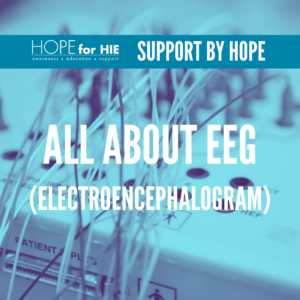
EEGs can be very stressful to prepare for, live with, and clean up the literal mess they cause. But, with so many families going through them with their children, we’ve assembled the best advice, and some links from other vetted medical organizations to help you out.
EEG (Electroencephalogram) is a tool that is used to read how the electrical circuitry of the brain works. Most HIE children have had them at onset of their HIE, either in the NICU or PICU to look at how their brain is working, and what areas might be impacted. Follow up EEGs may be used for all sorts of reasons – determining if it is safe to come off of anti-seizure medications, to look at the brain at different times of day such as the sleep/wake cycle, to look for spikes that may be causing, or could cause, seizures, and the identification of specific EEG waveforms that could give diagnoses on specific types of seizures and epilepsy.
The EEG requires leads/electrodes to be short-term glued to the scalp in difference regions of the head to capture the activity. These leads, or monitors, are typically attached to wires that feed to the EEG machine. However, there are many prototypes being worked on for wireless EEGs, and other less cumbersome ways to get a good brainwave reading.
Sleep-Deprived EEG – This is when you are asked to either keep your child awake for an extended period before the EEG, or wake up your child very early before the EEG. This is done to simulate impact on sleep. HIE has been shown to impact the sleep/wake cycle, and this is also a common type of EEG, regardless of HIE. These are typically done in an outpatient setting for 20-30 minutes, but could be as long as 1-2 hours of monitoring. They may also test photosensitivity and hyperventilation.
Ambulatory EEG – These are done either in the outpatient or at-home setting, usually from 1-3 days, 24/7, and the leads feed through to a wearable, portable backpack. Sometimes this will also be done in conjunction with video monitoring.
Overnight Inpatient EEG – For extended time that may be necessary to get a full picture of brainwaves, inpatient EEGs may be ordered, and a patient may spend time on an Epilepsy Monitoring Unit (EMU). The time can range from overnight to several days, with or without video monitoring. This may be necessary for several reasons, including complex epilepsies, medication changes, identifying nocturnal epilepsies, and more.
Your medical team should give you specific instructions about how to prepare for the EEG, depending on what type you are getting, such as instructions on sleep restrictions, bathing, etc.
If you are due for an inpatient EEG, packing activities and comforts from home like your own pillow, stuffed animals, toiletries, charging cords, snacks, etc. is recommended. Also, most EEG electrodes will be covered in a head wrap. Some families choose to decorate this with stickers to make it more fun during the process. Check with your team to ensure you don’t accidentally disconnect an electrode, and ask for child life services if you are doing an inpatient EEG.
An EEG technician will place the electrodes with short-term glue on the scalp, and set up the electrodes into the EEG machine. You may or may not have a video monitor with live readings of the EEG. Unless you are a trained professional, it will likely be very difficult to understand the patterns you are seeing, and this sometimes causes unnecessary anxiety for parents as they attempt to interpret results. A pediatric neurologist will be interpreting the results and they may be communicated to you that same day, or within a certain time afterwards.
You’ll likely get advice from your medical team about this, too, but our community has lots of tried and true methods! After the EEG is complete, it’s time to get all that glue out of your child’s hair. Here’s a list of the best ways that work for our families:
Connect with families, read inspiring stories, and get helpful resources delivered right to your inbox.